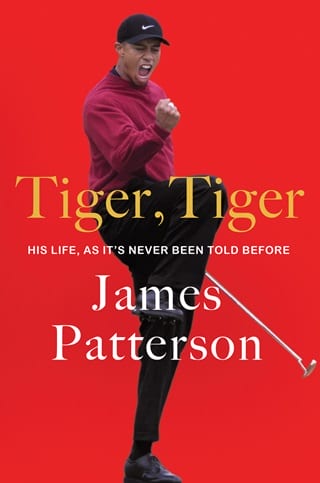Chapter 19
NCAA championship
Honors Course
Ootelwah, Tennessee
May 29–June 1, 1996
Of the thirteen tournaments Tiger plays as a Stanford sophomore, he wins nine.
“It was eye-opening from so many different perspectives,” says Joel Kribel, a freshman on the Stanford golf team. “He made people who’d been No. 1 look like they didn’t stand a chance. If he was playing halfway decent, it was kind of soul-crushing for a lot of guys to know, I could play my best and get lapped by this guy.”
With last year’s redshirted senior players now graduated, Tiger’s best friend on the team is upperclassman Jerry Chang, a fellow Californian he already knew from the junior circuit and who took over as this year’s team captain. The two are often roommates on the road.
At the 1996 NCAA championship, on the Honors Course, in Ootelwah, Tennessee, the players struggle with the tall, thick grass lining the fairways. Chang plops two balls in the water on the 16th. “I jokingly blame Tiger for bringing these big crowds to college golf and all the nerves that go with playing in front of crowds,” Chang says.
Tiger and Chang usually decompress back at the hotel by watching TV or doing homework, but the night before the final round, the team gets together to celebrate the season. “Tiger really enjoyed that team aspect,” Kribel says. After scoring 69-67-69 in the first three rounds, Tiger has high hopes for the June 1 final, but “he didn’t take any lead for granted,” says Chang.
The next day, the twenty-year-old shoots four times his age. It’s a shock for everyone—especially Tiger. “It doesn’t feel like I shot 80,” he tells reporters. “I’m exhausted right now. People will never know how much it took out of me. I had to dig really deep, give all I had.”
Tiger had gone into the final round with a nine-hot lead, so he still wins the NCAA men’s individual trophy by four strokes over the University of Arizona’s Rory Sabbatini. The Stanford team—national champions in 1994, months before Tiger joined—places fourth.
There’s always next year, Tiger tells fellow sophomore teammate Eri Crum. He’s not planning to leave Stanford early. “Unless,” he says, hedging, “something happens at the British Open.”
Tiger next attends the Memorial Tournament, at Muirfield Village Golf Club, not as a player but an honoree. On June 2, he accepts the Jack Nicklaus Award, given to the college player of the year. He shakes Nicklaus’s hand and assures the pro that he’ll graduate with his Stanford class of 1998.
The Golden Bear will be watching closely as the latest “Bear apparent” competes in the upcoming U.S. Open and British Open.
On June 13, Tiger takes an unusual first-round lead in the U.S. Open, at Oakland Hills Country Club, in Bloomfield Hills, Michigan. But in the end, the amateur buckles under professional-grade pressure, concluding the round with three bogeys, a double bogey, and a quadruple. He shoots 294 (76–69–77–72) and finishes eighty-second.
After the tournament, Tiger appears on The Tonight Show. The host, Jay Leno, shows his audience a picture of baby Tiger posing with a golf club.
“You don’t see many pros in diapers,” Leno says.
Tiger’s ready with a comeback. “I should have had one on at the Open.”
In England for the British Open from July 18 to July 21, twenty-year-old Tiger samples the local cuisine—McDonald’s. Between his hotel and Royal Lytham & St Annes Golf Club are two outlets of the American chain restaurant. The burgers taste like home cooking.
“There’s a difference between here and the States, but not much,” Tiger says. “I order a super-size fries and get about as many as I get in a large in the States. The food isn’t as greasy, either, and I love the grease. Just about wherever I go, if there’s a McDonald’s, I’ll find it.”
Two years ago, Tim Southwell, a reporter from the UK, came to interview Tiger in Cypress for the inaugural edition of a magazine called Loaded and found the young superstar enjoying a cheeseburger for breakfast. “No minders, no entourage, no dramas. Just Woods and his cheeseburger,” says Southwell.
“Wow,” Tiger said, wiping his hands before greeting the reporter. “You really made it all the way over here just to see me?”
“Well, you are going to be the next great golfer, right?” Southwell said.
“Sure,” replied Tiger. “And not the best black golfer either. The best, ever. Period.”
His confident sound bite doesn’t account for the 174 pot bunkers strategically positioned across the Lytham course, described by a leading British golf writer as “a beast.” On Thursday, July 18, Tiger has a rough start.
Jack Nicklaus pulls Tiger aside, saying, “I don’t ever want to see you shoot 75 in the first round of a tournament.”
Tiger takes the impromptu lecture as a sign that Nicklaus “cares about me that much. I came to understand that to win a major, or any golf tournament, you can’t win it on the first day, but you can lose it on the first day. And I lost it on the first day. When you’re not playing well, you still need to get it in the clubhouse around even par. I learned it the hard way.”
On Friday, he ups his game, scoring a 5-under 66.
Nicklaus turns in an identical round.
Tiger ultimately finishes twenty-second, his best-ever showing in a professional event so far. It also wins him the Silver Medal for Low Amateur.
The good feelings fade quickly when two weeks later, he takes a first-round loss to the 1994 U.S. Junior champion, Terry Noe, at the Western Amateur in Benton Harbor, Michigan.
“I’m outta here,” Tiger tells reporters looking for a comment.
He’s got nothing to say to anyone. Except Earl. He tells his father he’s now leaning toward turning pro.
Earl and Tida support his choice—on one condition.
“I want you to finish school because Jack Nicklaus did not finish school,” Earl says. “Arnold Palmer did not finish school. Curtis Strange did not finish school.”
Tiger promises his parents that a college diploma will happen in the future—the distant future.
Once teenage Tiger started playing his first PGA Tour events on top-tier courses and with top-of-the-line equipment, he said, “Daddy, I can get used to this very easy.”
Now he says, “I’m ready, Pop.”
 Fullepub
Fullepub 



